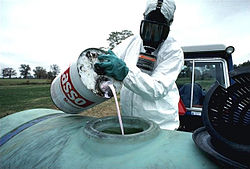1992 explosion
On Monday 21 September 1992, an explosion at the factory killed five workers, and injured around two hundred people. At 13.20 a distillation column still base containing residues of nitrotoluene ignited. The 200ft jet fire went through the site's control room and killed two men instantly. The fireball then entered a four-storey office block; a woman and two men died from their injuries later. The explosion cost £3.5 million.It made schools in the area shut down.
A nearby traffic warden made the first emergency call at 1.22pm. The ambulances took the first of the injured at 1.46pm, to the A&E at Pontefract General Infirmary.
54 year old George Potter, of Broadmead, Castleford, had two sons, and six grandchildren. 38 year old David Wilby, of Rookhill Mount, Chequerfield, Pontefract, was married with a son and daughter. Both died instantly.
18 year old Sara Atkinson had been at the factory for only five weeks, from Hallfield Avenue in Micklefield, on a six-month attachment; she was found slumped in a second-floor office block toilet, being found by the firemen at 2.03pm. When being airlifted to Pinderfields Hospital, she had a heart attack, caused by the asphyxiation from so much smoke inhalation, whilst in the West Yorkshire Police helicopter. She had been put on a life-support machine in the coronary care unit, and had not recovered. The machine was switched off on Thursday 24 September at 2.15pm, in consultation with her parents. [4]
Most of the staff in the four-storey office building had gone elsewhere for their lunch, at the time of the explosion.
Three other people were in the control room, where the two men had died instantly from the intense heat. Process technician 42 year old John Hopson, a father of two from Lumley Street in Castleford, had 45% burns. Manufacturing controller 29 year old Neil Gaffeney, of Birch Grove, Townville, Castleford, married with a child, had 58% burns. Both were on ventilators in the regional burns unit of Pinderfields, and never survived. But team leader 55 year old Terry Douthwaite was also in the burns unit, with less severe injuries, and did survive. Neil Gaffeney had the artificial respirator turned off on Saturday 26 September. [5] John Hopson died three weeks later on 12 October. [6]
Around 100 fire service personnel tackled the blaze, with 22 appliances from Castleford, Pontefract and Normanton. Ten of these personnel were put in an isolation ward of Pinderfields Hospital, with effects of cyanosis affecting their fingers (blue fingers). Another nine fire service personnel were in a non-isolation ward of the same hospital and Dewsbury and District Hospital, with symptoms of chemical poisoning. 181 people suffered from nausea and vomiting. [7] 28 rescue staff were treated for diarrhoea and nausea. [8] [9]
The health investigation was led by Dr Alison Evans, the public health director of Wakefield Health Authority, and Dr Sally Pearson and Dr Virginia Murray of National Poisons Unit. [10] This poisoning was looked at by the Employment Medical Advisory Service, and the National Poisons Unit (medical toxicology unit) at Guy's Hospital in London. The vomiting was later traced to polluted water, and the norovirus.
It went to court on Friday 30 July 1993, and the company was fined £250,000 with £150,000 costs. The families had wanted charges of manslaughter, but the CPS said that there was not enough evidence. [11] [12]




